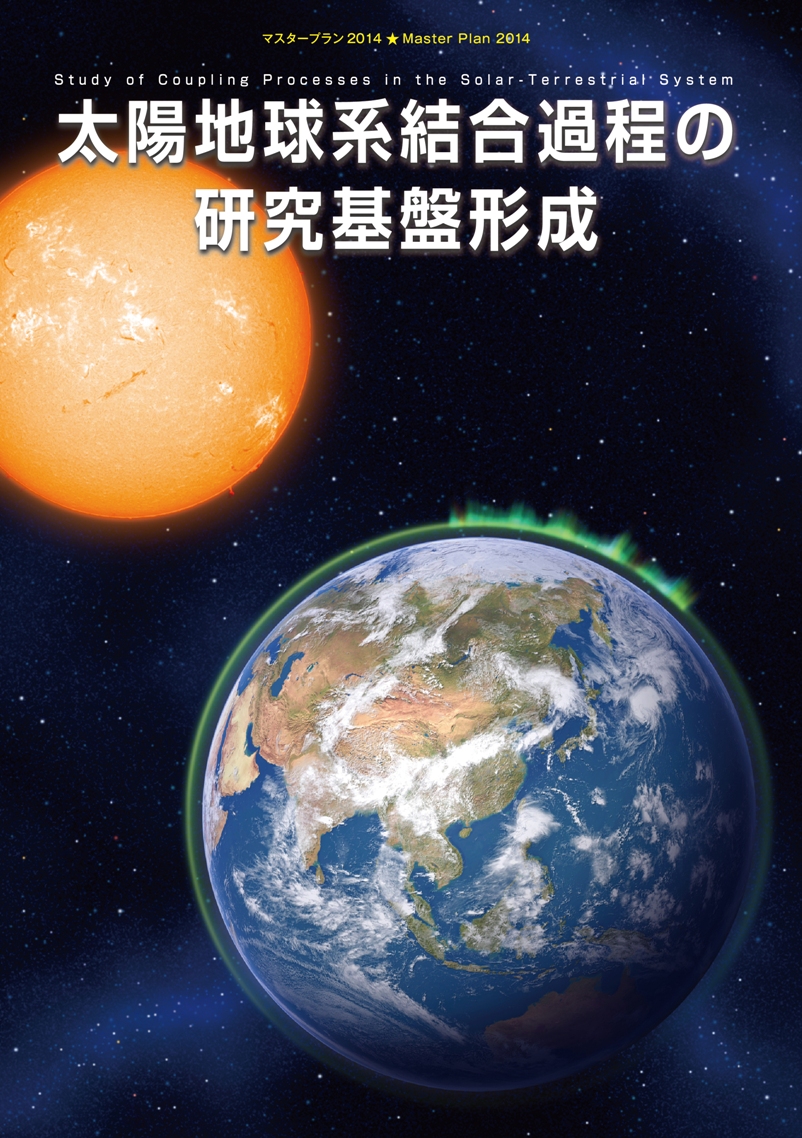
Japanese
Outline
"Coupling process in the solar-terrestrial system" aims to study the solar energy inputs into the Earth, and the response of Geospace (magnetosphere, ionosphere and atmosphere) to the energy input.
The solar energy can mainly be divided into two parts - the solar radiation involving infra-red, visible, ultra-violet and X-ray, and solar wind which is a high-speed flow of plasma particles.
The solar radiation becomes maximum at the equator, and atmospheric disturbances are actively generated near the Earth's surface.
They further excite various types of atmospheric waves which propagate upward carrying energy and momentum.
On the other hand, the energy associated with the solar wind converges into the polar regions where disturbances are generated.
A part of the energy is transported toward lower latitudes and lower atmospheric regions.
We propose to establish large atmospheric radars with active phased array antenna at the equator and the arctic region.
Among the equatorial regions, we focus on the Indonesian region where atmospheric disturbances are most intense.
We will establish a comprehensive observatory in Indonesia with the Equatorial MU (EMU) radar as its main facility.
Alongside, we will take part in the construction of the state-of-the-art radar, called EISCAT_3D, in northern Scandinavia under international collaborations.
We will also develop the global observation network of portable equipment from the equator to both polar regions, and study the flow of the energy and materials in the whole atmosphere.
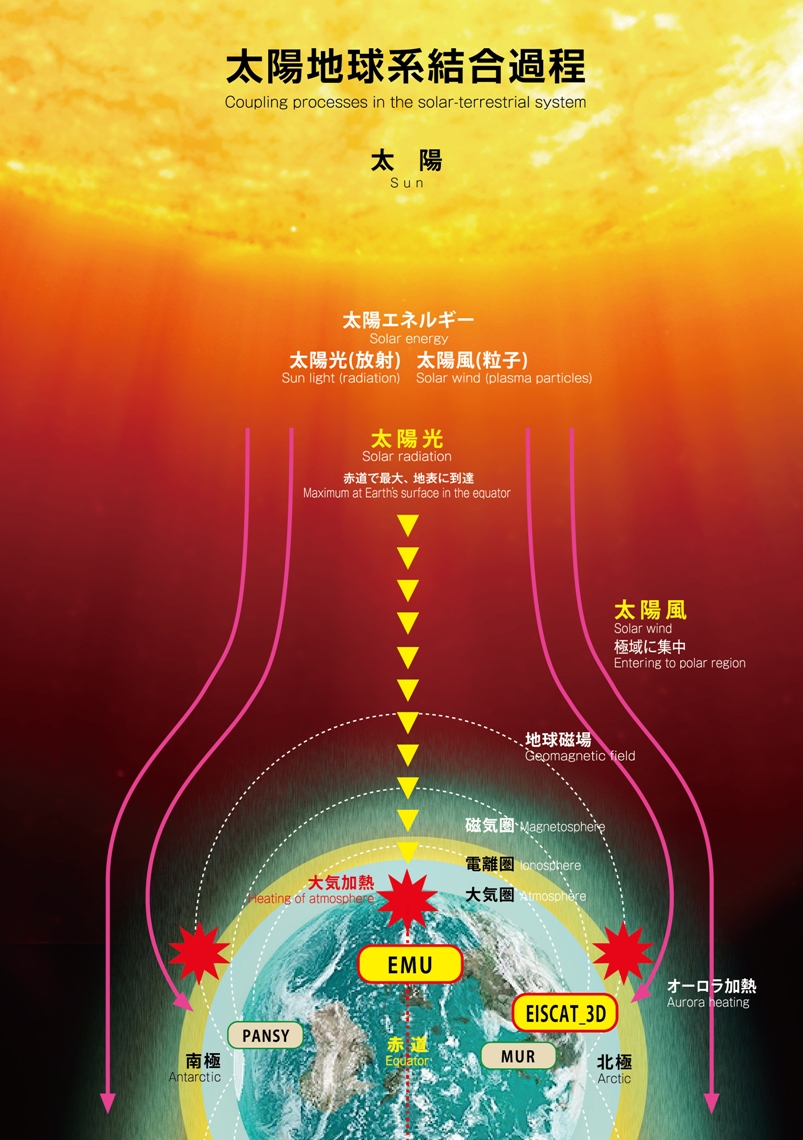
Equatorial Fountain
Cumulonimbus convection is active in the equatorial atmosphere.
It generates various types of atmospheric waves that propagate upward to transport energy and momentum into the upper atmosphere including the ionosphere.
Also, different kinds of materials (atmospheric minor constituents) originating at low- and mid-latitude regions and converging into the equatorial region are blown upward through the tropopause; they eventually reach the middle atmosphere and spread to the whole globe. In the upper atmosphere, there are plasma disturbances, and equatorial ionization anomaly (EIA) is generated around the equator.
We will capture the energy and material flow that occur in all height ranges of the equatorial atmosphere as "Equatorial Fountain" using the Equatorial MU Radar (EMU).
We already established in 2001 the Equatorial Atmosphere Radar (EAR) in West Sumatra, Indonesia and continued observations under international collaborations.
In this project we propose to develop EMU, the new radar that is 10 times more sensitive than the EAR.
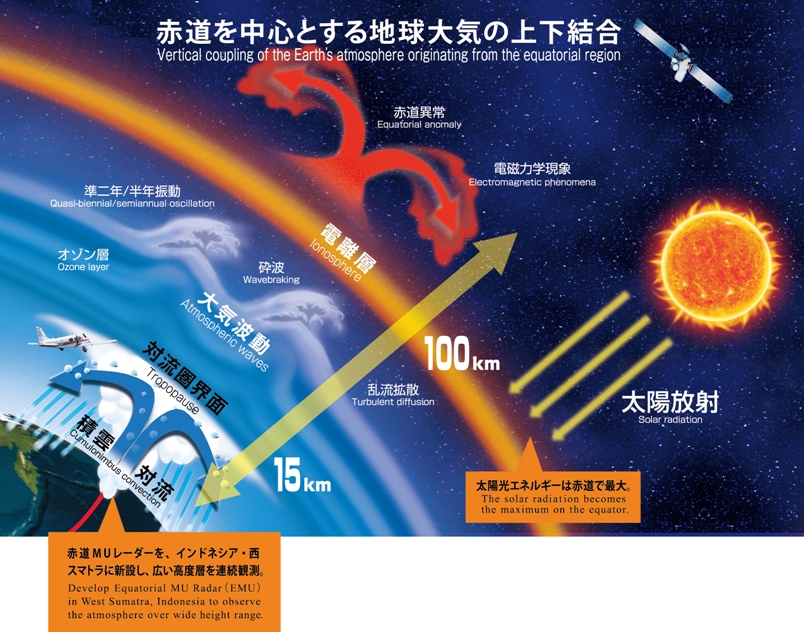
Research on energy input into the polar upper atmosphere and its response
The new IS radar "EISCAT_3D" will give us great opportunities to make major breakthroughs in the science of Solar-Terrestrial Physics.
High energy particles precipitate from the magnetosphere into the polar upper atmosphere along Earth's magnetic field lines and create interesting phenomena such as "aurora borealis display".
Part of the energy from the solar wind changes its form, and is transported to the lower atmosphere and to lower latitude regions.
On the other hand, the polar region is also the area where part of the Earth's atmosphere outflows to the space.
The phenomena occurring in the polar upper atmosphere are characterized by their rapid variability in time and space.
The EISCAT_3D radar will have a unique capability to investigate 3-dimensional structures of the upper atmosphere and ionosphere with high temporal and spatial resolution.
We will take part in the construction the EISCAT_3D radar system in northern Scandinavia under international collaboration with the EISCAT scientific association of which Japan has been a member since 1996.
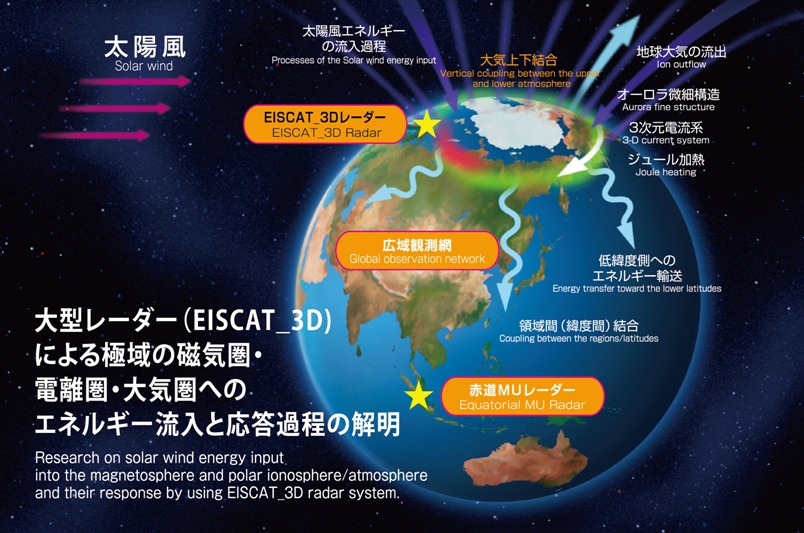
Global observation network
We developed the MU radar in Japan, which is the first application of active phased array antenna to atmospheric radars, and extended it to similar radar systems in overseas bases.
This technical innovation is adopted by foreign research groups for the development of other radars.
Based on this heritage, we will establish much more advanced state-of-the-art radars in the equatorial and polar regions.
We will then move to establish international collaboration of the large radars.
We also expand observation network of small instruments to the Asian and African regions where observations are not well established, fulfill the global observation network from the equator to the pole, and will elucidate global flow of energy and materials.
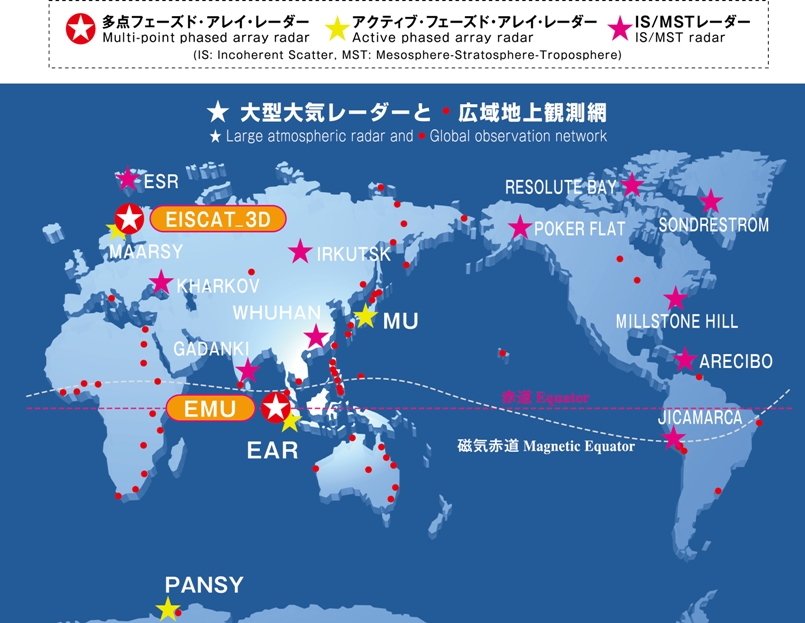
National and international research trends
Study of the coupling processes in the solar-terrestrial system has been internationally discussed by SCOSTEP (Scientific Committee on Solar-Terrestrial Physics) under ICSU (International Council for Science).
Japan's contribution to the study was then decided through discussions at Science Council of Japan (SCJ).
Since International Geophysical Year (IGY in 1957-1958), many international research programs of 5-10 year long were continuously conducted.
Now the new project VarSITI (Variability of the Sun and Its Terrestrial Impact) is running in 2014-2018 after CAWSES (Climate and Weather of the Sun-Earth System) in 2004-2013.
Japan contributed much to these programs through observations especially using large atmospheric radars.
We developed the MU radar in Japan in 1984, the Equatorial Atmosphere Radar (EAR) right over the equator in 2001, joined EISCAT scientific association to enhance observations of the polar-region in 1996, and recently developed PANSY radar at Antarctic Syowa station.
Observation network of magnetometers and airglow imagers were expanded to large areas all over the world in parallel with these efforts.
For enhancing the management and use of the large amount of data from observations with these facilities, we are now running a project IUGONET (Inter-university Upper atmosphere Global Observation NETwork).
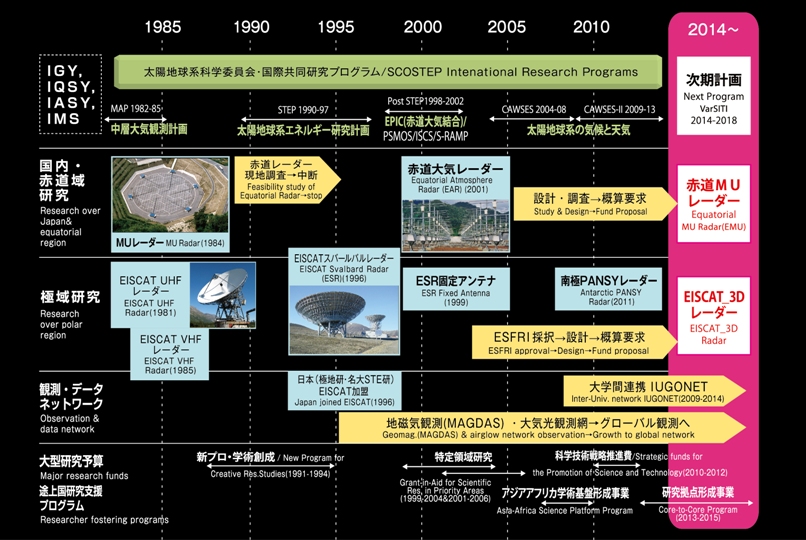
National/International cooperation
This plan is widely supported by national and international scientific communities.
The development of the Equatorial MU Radar gains full support from the Indonesian Government, similar to the EISCAT_3D project that progressed with international discussions with the associate countries in Europe and China.
We have been pioneering atmospheric radars with innovative technology.
We will lead the international research programs and continue to have advantages in the solar-terrestrial studies.
We have already established the consortium for mutual use of large-volume data from the observations.
These data will be used in the World Data System, and will be an example of "big data".
Effect from the plan and capacity building
Understanding of the solar-terrestrial system may help studies of the atmospheric environment of extra-solar planets.
The development of the new radar has direct impact on radio science, informatics and electronics.
Results from our studies would improve the forecast accuracy of severe weather and/or space weather.
Our plan will serve national and international capacity building through field studies and/or international schools, which would contribute to peaceful diplomacy via science and technology exchanges.
Related scientific community
Japan: JpGU (Japan Geoscience Union) Section for Space and Planetary Sciences, SGEPSS (Society of Geomagnetism and Earth, Planetary and Space Sciences), Meteorological Society of Japan, IEICE (The Institute of Electronics, Information and Communication Engineers)
International: ICSU/SCOSTEP, URSI (International Union of Radio Science), IUGG (International Union on Geodesy and Geophysics), MST radar community, ISWI (International Space Weather Initiative)
Related overseas institutions
Indonesia: RISTEK (Ministry of Research and Technology), LAPAN (National Institute of Aeronautics and Space), BMKG (Indonesian Agency for Meteorology, Climatology and Geophysics), BPPT (Agency for the Assessment and Application of Technology), ITB (Bandung Institute of Technology), etc.
EISCAT science association Established in 1975 by Germany, UK, France, Norway, Sweden, and Finland. Japan and China joined in 1996 and 2007, respectively.
Proposed by
Pamphlet Download





